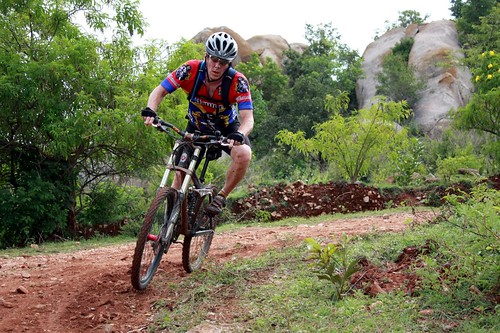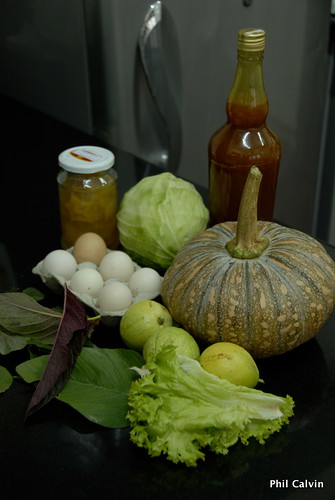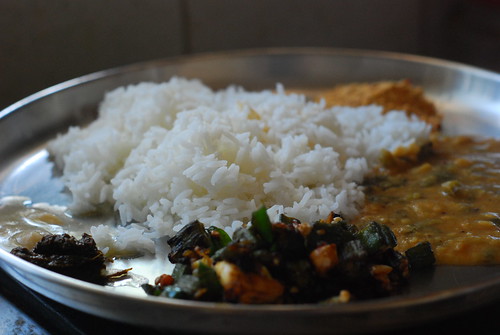Number two on my list of things I'll miss when I leave Bangalore.

Me in a race near Bangalore
When I first moved to Bangalore, I was too scared to go out on the roads on a bicycle. By any foreign standard, the drivers here are just incredibly shockingly bad. The statistics don't lie. Just one: India has more deaths on the highway per mile/km driven than anyone else by a large margin. But Indian drivers are a topic for another post.
I did eventually get a motorcycle (a 1962 Royal Enfield Bullet, again, more on that later) and by riding in the rural areas between Bangalore gradually built up some more courage to tackle the roads. I had brought all my bicycles to Bangalore but had been too busy with work and a young family life to think about riding much except with my daughter around the neighborhood.
And then I learned about a group of mountain bikers in the Whitefield area who rode on Sunday mornings. One morning with some trepidation I joined them and I was hooked again. I say again because I had been riding MTB since 1988, and raced road-bikes in 1980-84.
East of Whitefield, however, it's a paradise of trails. You can ride and ride and ride, and never know all the trails. And the scenery changes all the time with the change in seasons and crops. Part of what makes it so easy is that no one out there bothers to fence their land. And people walk everywhere, so there are lots of footpaths through rural areas.
The villages are spread out about 5km apart on average, so you have lots of opportunities to stop for water and snacks. There is a river that splits the area, and there are only a couple of places to cross the river. Typically we leave Whitefield and decide to go either North or South along the river, then cross further east, and either make it into a loop or an out-and-back, depending on time/effort.
The landscape varies, is mostly flat, but there are some small hills. In the low & wet areas rice paddies and coconuts dominate. In the higher areas, there are brick-making works, sand pits, and some stone mining operations. In the middle there are lots of "forests" where wood is grown for firewood and building materials.

View from the trail between Harohalli and Muthsandra at sunrise
Generally, we are stopped by flat tires at least once in a trip. The more riders that show up, the higher the likelihood of that. With tubeless tires (Stan's no-tubes) it happens a lot less frequently.

One of the old swimming holes. This one was pumped dry recently.
We have discovered places to swim in water wells and quarries and most villages will sell you a mid-morning snack of chai and bananas, if not something more filling like idly if you can stomach the sanitation of rural kitchens.
The Sunday morning ride is the highlight of my week in Bangalore.

Me in a race near Bangalore
When I first moved to Bangalore, I was too scared to go out on the roads on a bicycle. By any foreign standard, the drivers here are just incredibly shockingly bad. The statistics don't lie. Just one: India has more deaths on the highway per mile/km driven than anyone else by a large margin. But Indian drivers are a topic for another post.
I did eventually get a motorcycle (a 1962 Royal Enfield Bullet, again, more on that later) and by riding in the rural areas between Bangalore gradually built up some more courage to tackle the roads. I had brought all my bicycles to Bangalore but had been too busy with work and a young family life to think about riding much except with my daughter around the neighborhood.
And then I learned about a group of mountain bikers in the Whitefield area who rode on Sunday mornings. One morning with some trepidation I joined them and I was hooked again. I say again because I had been riding MTB since 1988, and raced road-bikes in 1980-84.
East of Whitefield, however, it's a paradise of trails. You can ride and ride and ride, and never know all the trails. And the scenery changes all the time with the change in seasons and crops. Part of what makes it so easy is that no one out there bothers to fence their land. And people walk everywhere, so there are lots of footpaths through rural areas.
The villages are spread out about 5km apart on average, so you have lots of opportunities to stop for water and snacks. There is a river that splits the area, and there are only a couple of places to cross the river. Typically we leave Whitefield and decide to go either North or South along the river, then cross further east, and either make it into a loop or an out-and-back, depending on time/effort.
The landscape varies, is mostly flat, but there are some small hills. In the low & wet areas rice paddies and coconuts dominate. In the higher areas, there are brick-making works, sand pits, and some stone mining operations. In the middle there are lots of "forests" where wood is grown for firewood and building materials.

View from the trail between Harohalli and Muthsandra at sunrise
Generally, we are stopped by flat tires at least once in a trip. The more riders that show up, the higher the likelihood of that. With tubeless tires (Stan's no-tubes) it happens a lot less frequently.

One of the old swimming holes. This one was pumped dry recently.
We have discovered places to swim in water wells and quarries and most villages will sell you a mid-morning snack of chai and bananas, if not something more filling like idly if you can stomach the sanitation of rural kitchens.
The Sunday morning ride is the highlight of my week in Bangalore.



















